|
32 Faculty
Named UF Research Foundation Professors
click here to see
professor list
The University of Florida Research Foundation (UFRF) has named 32 faculty
members who have a distinguished current record of research and a strong
research agenda that is likely to lead to continuing distinction in their
fields as UFRF Professors for 2001-2004.
The UFRF professors were recommended by their college deans based on nominations
from their department chairs, a personal statement and an evaluation of
their recent research accomplishments as evidenced by publications in
scholarly journals, external funding, honors and awards, development of
intellectual property and other measures appropriate to their field of
expertise. The three-year award carries with it a $5,000 annual salary
supplement and a $3,000 grant.
“Much of the information in the nomination packets comes from department
chairs and colleagues who know better than anyone the status these researchers
have achieved in their respective fields,” said Win Phillips, vice
president for research. “Words like ‘cutting edge,’ ‘innovative,’
‘most productive’ and ‘revolutionary’ are testament
to the respect these peers have for their colleagues.
“Another constant among UFRF Professors is the importance they place
on teaching,” Phillips added. “Despite often extensive research
activities, these faculty are often also the recipients of outstanding
teaching awards.”
The professorships are funded from the university’s share of royalty
and licensing income on UF-generated products.
$3.9
Million Grant To Fund New Agroforestry Center
by Tom Nordlie
To promote environmentally friendly farming practices in the Southeast,
the University of Florida’s Institute of Food and Agricultural Sciences
is establishing a new Center for Subtropical Agroforestry with the aid
of a $3.9 million grant from the U.S. Department of Agriculture.
P.K. Nair, distinguished professor in the School of Forest Resources and
Conservation, said the center will provide teaching, research and extension
in agroforestry, a new farming practice that grows crops and animals alongside
of trees or shrubs.
“We’ve waited years for this,” said Nair, who will serve
as the center’s director. “It’s the first time a government
agency has provided substantial funding for agroforestry in the southeastern
U.S.”
He said scientific agroforestry practices are relatively unknown to industrialized
nations but are common in tropical regions, where limited-resource farmers
grow trees in crop fields to produce firewood and other products.
“In the United States, agroforestry could bridge the gap between
commercial agriculture and traditional farming,” Nair said. “It
could help smaller farms diversify, enhance revenues and become more sustainable.
It also promotes conservation of land and wildlife habitat.”
To give the center a regional perspective, UF experts will collaborate
with representatives of Florida A & M University, Auburn University,
the University of Georgia and the University of the Virgin Islands.
The center will pursue eight research projects and four extension projects.
One research project involves farming pine trees on cattle pastureland.
Another will focus on interaction between trees and crops, which often
compete for resources.
Before the public supports agroforestry, it must become aware of it, said
Alan Long, UF associate professor of forest operations. Long and UF natural
resources assistant Professor Martha Monroe are coordinating the center’s
four extension projects with the help of Sarah Workman, a newly recruited
research assistant professor with the agroforestry center.
One extension project will establish demonstration areas on farms where
landowners can view agroforestry cultivation, Workman said.
P.K. Nair, pknair@ufl.edu
Genetically
Modified Earth Plants Will Glow From Mars
by Paul Kimpel
In what reads like a story from a 1950s science fiction magazine, a team
of University of Florida scientists has genetically modified a tiny plant
to send reports back from Mars in a most unworldly way: by emitting an
eerie, fluorescent glow.
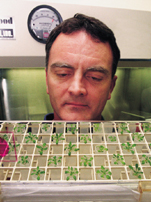
If all goes as planned, 10 varieties of the plant could be on their way
to the red planetas part of a $300 million mission scheduled for 2007.
The plant experiment, funded by $290,000 from NASA's Human Exploration
and Development in Space program, may be a first step toward making Mars
habitable for humans, said Rob Ferl, assistant director of the Biotechnology
Program at UF.
Ferl and a team of molecular biologists chose as their subject the Arabidopsis
mustard plant. They picked it, Ferl said, because of three attributes
that make it ideally suited for the Mars mission: its maximum height is
8 inches, its life cycle is only one month and its entire genome has been
mapped. Moreover, in December 2000 it became the first plant to have its
genetic sequence completed.
To create the glow, the team will insert "reporter genes" into
varieties of the plant that will express themselves by emitting a colored
glow under adverse conditions on Mars. Each reporter gene will react to
an environmental stressor such as drought, disease or temperature. For
example, one version will glow an incandescent green if it detects an
excess of heavy metals in the Martian soil; another will turn blue in
the presence of peroxides.
Ferl's team, in collaboration with Andrew Schuerger, a manager of Mars
projects at the Kennedy Space Center-based Dynamac Corp., is competing
with other biologists to receive the NASA contract for the Mars trip.
.
The 2 1/2-year Mars mission — nine months traveling 286 million miles
each way and one year stationed on the planet - would work like this:
The seeds of the plant would make the trip aboard a spacecraft similar
to NASA's Mars Odyssey, which was launched April 7. Upon arrival, the
landing vehicle's robot would scoop up a portion of Martian soil, and
the scientists would analyze it using the robot and a specialized camera.
After modifying the soil with fertilizers, buffers and nutrients, the
scientists will germinate the seeds and grow the plants in a miniature
greenhouse on the landing vehicle.
Rob Ferl, robferl@ufl.edu
Andrew Schuerger, chueac@kscems.ksc.nasa.gov
UF Seeks
To Preserve Historic Cuban Archive
 The
University of Florida is launching an effort to preserve and make accessible
a veritable gold mine of rare historic documents in Cuba's National Archives
that chronicle three centuries of Spain's colonization of the New World. The
University of Florida is launching an effort to preserve and make accessible
a veritable gold mine of rare historic documents in Cuba's National Archives
that chronicle three centuries of Spain's colonization of the New World.
Known as the Notary Protocols, these archival holdings in Havana are bound
in 6,658 tomes, each containing an estimated 1,300 handwritten pages (the
equivalent of about 40,000 volumes in a modern library). They track the
comings and goings of many ships that sailed and nearly every person who
traveled between Spain and the New World from the 16th through 19th centuries,
said John Ingram, director of library collections at UF's George A. Smathers
Libraries.
"We are embarking on a unique opportunity that will benefit present
and future generations of scholars, students and the interested public,"
Ingram said.
The preservation effort will bring both microfilm and digital technology
to bear on the archives' deteriorated papers. When funding is secured,
specialists will travel to Havana and begin a 12- to 18-month pilot program
for the lengthy and painstaking process of transferring the entire collection
to microfilm and digital formats. Afterward, a guide to the materials
will be posted on the Internet, and users will be able to obtain copies
of individual documents on compact disc.
The project is the result of an agreement signed in March by UF and the
Cuban National Archives. Ingram said the documents are especially relevant
to Florida, where notary archives for the First Spanish Period (1565-1764)
were lost during the U.S. invasion of Florida in 1812. The Notary Protocols
will likely contain information on the outfitting of early expeditions
to Florida and underscore the great dependence that Florida had on Cuba
in almost all aspects of Spanish colonial life.
For more than 300 years, notaries in Havana recorded detailed information,
dutifully registering travelers' wills, legal documents and the cargos
they might be carrying. The result, Ingram said, is a priceless archive
of materials that many specialists regard as the single most important
source of information on the New World's colonial history. Regarded as
uniquely valuable to this history for more than 100 years, yet rarely
consulted because of their location and a general lack of resources to
expose their value to scholars, the thousands of tomes will be a genuine
treasure for research.
The cost of the project will be paid for with money raised from foundations
and private donations, Ingram said. No federal or state tax dollars will
be used. With the completion of a successful pilot program, and to make
the larger effort possible, the UF library seeks to team up with U.S.
and Spanish libraries and institutions in enlisting funding support for
the entire project.
"I am convinced that the Protocolos Notariales in Cuba's archives
will assume their rightful place of global importance for New World history
and culture," Ingram said. "For my colleagues in Latin American
studies, these records will truly open a window in time."
John Ingram, jeingr@mail.uflib.ufl.edu
Peppers
Rely On "Zing" To Spread Seeds
by Aaron Hoover
It adds the fire to chili and the hot to salsa, but what does the zing
do for the pepper?
As it turns out, quite a lot. Working with the ancestor of most varieties
of chili pepper plants, a University of Florida researcher has shown that
the plant relies on its spiciness to ensure the very survival of its species.
 In
an article in the journal Nature in July, Josh Tewksbury, a UF postdoctoral
researcher in zoology, and co-author Gary Nabhan, an ethnobotanist at
Northern Arizona University, conclude that mammals, sensitive to the chemical
that makes peppers taste hot, avoid the Capsicum annuum pepper. Birds,
however, are unaffected by the chemical, known as capsaicin, and they
happily eat the peppers. This is essential for the plant, since birds
release the seeds in their droppings ready to germinate - whereas if mammals
ate the seeds, they would crunch them up or render them infertile, the
researchers report. In
an article in the journal Nature in July, Josh Tewksbury, a UF postdoctoral
researcher in zoology, and co-author Gary Nabhan, an ethnobotanist at
Northern Arizona University, conclude that mammals, sensitive to the chemical
that makes peppers taste hot, avoid the Capsicum annuum pepper. Birds,
however, are unaffected by the chemical, known as capsaicin, and they
happily eat the peppers. This is essential for the plant, since birds
release the seeds in their droppings ready to germinate - whereas if mammals
ate the seeds, they would crunch them up or render them infertile, the
researchers report.
"The upshot is that it's very beneficial for the pepper to have mammals
avoid its fruit and have birds attracted to them," Tewksbury said.
Plants that produce apparently poisonous or undesirable fruits - the edible
reproductive body of a seed plant - have long puzzled biologists. Evolutionary
theory says the main reason that plants create fruits is to encourage
animals to eat them, so that the animals will disperse the plant's seeds.
Why, biologists wonder, would plants go to the trouble of making a fruit,
only to use chemicals to deter an animal and potential seed distributor?
Evolutionary biologist Dan Janson proposed in the late 1960s that plants
may use chemicals to deter some animals without deterring others, thus
selecting only preferred seed distributors. Known as "directed deterrence,"
this theory received very little attention and was never observed in nature,
and it gathered dust in scholarly journals until Tewksbury and Nabhan
decided to see if it might hold true in chili peppers.
The researchers did their investigation in a field in southern Arizona
about 35 miles south of Tucson, using the Chiltepine chili pepper, Capsicum
annuum. The plant is the progenitor of virtually all peppers native to
North America, including jalapeno, poblano and bell peppers.
Using video cameras trained on the plants, they discovered that birds
- in particular, a species known as the curve-billed thrasher - were the
only animals eating the small, red peppers. Meanwhile, pack rats and cactus
mice, the dominant fruit- or seed-eating mammals in the area, avoided
the peppers entirely.
That was fine as far as it went, but Tewksbury and Nabhan needed to prove
that the rats and mice were avoiding the capsaicin chemical in the peppers.
To do so, they found a pepper similar in size, shape and nutritional content
to Capsicum annum. But because of a genetic quirk, the pepper,
a variety of Capsicum chacoense, completely lacks capsaicin.
The researchers fed this "spiceless" pepper to packrats, mice
and birds in labs. All gobbled it up. When the researchers swapped the
hot pepper with the spiceless pepper, the birds continued to eat the pepper,
but the rodents refused to even nibble it.
Analyzing the droppings and feces of the birds and rodents, the researchers
discovered that the birds passed the seeds whole and capable of germinating.
The rodents, however, chewed up most of the seeds, and any that remained
were too damaged to germinate.
To cap it off, Tewksbury and Nabhan discovered that the curve-billed thrashers
tended to spend a lot of time on a variety of fruiting shrubs, frequently
releasing their droppings there. The peppers, they discovered, grew much
better in the shade of the shrubs than the hostile open desert, which
comprises the majority of habitat. The chilies also have two additional
advantages: Birds are more likely to eat the pepper from chili bushes
growing near the shrubs, further dispersing the seed, and an insect that
kills the seeds and fruit of the pepper was much less common in the shade
of the shrubs.
So not only are the birds distributing undamaged pepper seeds, they are
doing so in just the places the resulting plants are most likely to thrive,
Tewksbury said.
"From the pepper's perspective, it's very beneficial to get pooped
out as a seed underneath a shrub, particularly a shrub that has fleshy
fruits itself, and that's just where the thrashers deposit the seed,"
he said.
Josh Tewksbury, jtewksbury@zoo.ufl.edu
Mysterious
Brown Dwarfs Are Likely "Failed Stars"
by Aaron Hoover
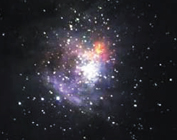 An
international research team led by University of Florida astronomers announced
in June that it had found dusty disks surrounding numerous faint objects
believed to be "brown dwarfs" in the Orion Nebula. An
international research team led by University of Florida astronomers announced
in June that it had found dusty disks surrounding numerous faint objects
believed to be "brown dwarfs" in the Orion Nebula.
Brown dwarfs, first observed about a decade ago, are mysterious gaseous
structures that do not shine from sustained nuclear fusion as stars do.
The findings of the new study suggest brown dwarfs may be more similar
to "failed stars" rather than to "super planets,"
forming from collapsing clouds of interstellar gas.
That means brown dwarfs, like stars, could have planets rotating around
them - although, without a proper sun, the planets likely wouldn't provide
an environment conducive to life, said Elizabeth Lada, a UF associate
professor of astronomy.
"It is entirely possible that our galaxy contains numerous planetary
systems that orbit these cold, dark, failed stars," Lada said. "But
even if brown dwarfs do have planetary systems, their planets would not
have a stable climate and thus would be inhospitable to life as we know
it."
The team, which announced its findings at the American Astronomical Society
meeting in Pasadena, Calif., based its conclusions on observations of
likely brown dwarfs in the so-called Trapezium cluster, a group of extremely
young stars within the Orion Nebula. Located about 1,200 light years from
Earth, the cluster and nebula appear to the untrained eye as a single
central star in the sword of the hunter in the constellation Orion. The
cluster is a kind of stellar nursery, with most of its stars aged less
than 1 million years old, in contrast to our middle-aged sun, which is
4 billion years old.
Stars are thought to form when gravity causes a rotating cloud of gas
to contract. Before the actual star is formed, the gas collapses into
a rotating disk. Most young stars observed to date have been accompanied
by such disks. Using a state-of-the-art, near-infrared camera on a European
Southern Observatory telescope in the Chilean Andes, the researchers found
disks surrounding both young stars and suspected brown dwarfs in the Trapezium
cluster. Moreover, the percentage of stars with disks matched the percentage
of brown dwarfs with disks.
That suggests brown dwarfs and stars share a common origin - one different
from planets, which form within disks surrounding stars but do not have
disks of their own. The observation is important because the small size
of brown dwarfs - they are less than 7 percent of the size of our sun
- had led some astronomers to speculate they were related more closely
to planets than stars.
The team also achieved another milestone. In analyzing the observations,
the astronomers identified at least 80 likely brown dwarfs, roughly doubling
the number of the structures identified so far. The brown dwarfs in the
Trapezium cluster constitute the largest "population" of brown
dwarfs ever observed, researchers said.
"Even at their brightest, most brown dwarfs are still 100 or more
times fainter than our sun, explaining why astronomers find such objects
so difficult to detect," said August Muench, a UF doctoral student
in astronomy and the project's lead investigator.
Elizabeth Lada, lada@astro.ufl.edu
Coastal
Ecosystems Collapse Tied To Past Overfishing
by Aaron Hoover
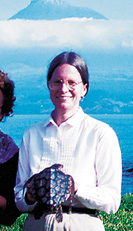 Dying
coral reefs, dwindling shellfish populations, shrinking seagrass beds
and other collapses of the world's coastal ecosystems are often blamed
on pollution or global warming. Dying
coral reefs, dwindling shellfish populations, shrinking seagrass beds
and other collapses of the world's coastal ecosystems are often blamed
on pollution or global warming.
But in a paper that appeared in the journal Science in July, 16
scientists and academicians from around the world argue that these trends
were set into motion by a much older human transgression: overfishing.
Beginning long before Columbus and accelerating rapidly in colonial and
modern times, people have radically overfished marine mammals, large fishes
and shellfish, according to the paper, whose co-authors include Karen
Bjorndal, a zoology professor and director of the Archie Carr Center for
Sea Turtle Research at the University of Florida.
The reduction of these animals to a fraction of their historical abundance
has caused ecological damage that remained hidden until recent decades,
when other circumstances triggered its full effects, the scientists say.
"What we're finding is a number of the crises that our marine ecosystems
are facing today can be traced back thousands of years in some cases,
and hundreds of years in others, to when human beings first began affecting
these ecosystems," Bjorndal says.
The paper discusses coastal ecosystems around the globe, hopscotching
from the Chesapeake Bay to the Caribbean to Australia's coastal waters.
It steps outside the bounds of pure ecological science, drawing on a broad
array of scientific literature, historical accounts and archaeological
evidence of aboriginal fishing practices.
The authors tie several recent downturns in the world's coastal ecosystems
to past overfishing. Examples include declining underwater kelp forests,
declining shellfish beds and shrinking seagrass beds.
Bjorndal's research ties overfishing of green sea turtles to the decline
of turtlegrass in Florida Bay and in the Caribbean. The turtles, which
eat only plants, prevent the turtlegrass from growing too long. In their
absence, the longer grass shades the bottom, slows the current and decomposes
on the sea bottom. This process both increases nutrients and encourages
turtlegrass diseases.
"One of our best estimates is that green sea turtle populations today
are 5 to 10 percent of what they were when Columbus arrived," Bjorndal
says. "The functional loss of this species has had a huge effect."
Despite evidence of massive declines in many populations, the authors
say most of the overfished species still survive in sufficient numbers
to permit restoration.
"If we want to restore these ecosystems, we have to understand how
they function, and just looking back a couple of decades isn't going to
tell us," Bjorndal says.
Karen Bjorndal, kab@monarch.zoo.ufl.edu
|
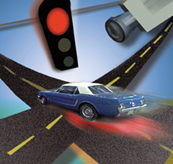 University
of Florida engineering researchers have developed an inexpensive system
to count red-light runners at intersections, a step that comes as advocates
of red-light camera ticketing systems pursue laws making them legal in
Florida.
University
of Florida engineering researchers have developed an inexpensive system
to count red-light runners at intersections, a step that comes as advocates
of red-light camera ticketing systems pursue laws making them legal in
Florida.
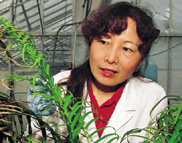 The
solution to one of man’s most vexing environmental problems may lie
in one of nature’s most remarkable plants.
The
solution to one of man’s most vexing environmental problems may lie
in one of nature’s most remarkable plants.
 The
University of Florida is launching an effort to preserve and make accessible
a veritable gold mine of rare historic documents in Cuba's National Archives
that chronicle three centuries of Spain's colonization of the New World.
The
University of Florida is launching an effort to preserve and make accessible
a veritable gold mine of rare historic documents in Cuba's National Archives
that chronicle three centuries of Spain's colonization of the New World. In
an article in the journal Nature in July, Josh Tewksbury, a UF postdoctoral
researcher in zoology, and co-author Gary Nabhan, an ethnobotanist at
Northern Arizona University, conclude that mammals, sensitive to the chemical
that makes peppers taste hot, avoid the Capsicum annuum pepper. Birds,
however, are unaffected by the chemical, known as capsaicin, and they
happily eat the peppers. This is essential for the plant, since birds
release the seeds in their droppings ready to germinate - whereas if mammals
ate the seeds, they would crunch them up or render them infertile, the
researchers report.
In
an article in the journal Nature in July, Josh Tewksbury, a UF postdoctoral
researcher in zoology, and co-author Gary Nabhan, an ethnobotanist at
Northern Arizona University, conclude that mammals, sensitive to the chemical
that makes peppers taste hot, avoid the Capsicum annuum pepper. Birds,
however, are unaffected by the chemical, known as capsaicin, and they
happily eat the peppers. This is essential for the plant, since birds
release the seeds in their droppings ready to germinate - whereas if mammals
ate the seeds, they would crunch them up or render them infertile, the
researchers report. An
international research team led by University of Florida astronomers announced
in June that it had found dusty disks surrounding numerous faint objects
believed to be "brown dwarfs" in the Orion Nebula.
An
international research team led by University of Florida astronomers announced
in June that it had found dusty disks surrounding numerous faint objects
believed to be "brown dwarfs" in the Orion Nebula. Dying
coral reefs, dwindling shellfish populations, shrinking seagrass beds
and other collapses of the world's coastal ecosystems are often blamed
on pollution or global warming.
Dying
coral reefs, dwindling shellfish populations, shrinking seagrass beds
and other collapses of the world's coastal ecosystems are often blamed
on pollution or global warming.